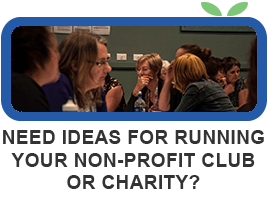Last updated April 12, 2016
There are literally hundreds of ways you can market your non-profit message to your community. Many require a considerable budget and at least some degree of time and effort, but many are easy and inexpensive to implement. The key is making the most of the marketing avenues you already have in place. Check out these simple and cost effective ways to market your non-profit message.
1. Sign Off
Instead of using your email signature to simply state your address and phone number, take the opportunity to say something important. You could write a couple of lines about an upcoming event, include a testimonial from a client, or talk about a specific fundraising campaign with a link through to your donations page. Get into the habit of changing your signature every month to reflect something current in your organisation.
2. Sign Off on Your Behalf
People listen most closely when messages come from people they know, like and trust – so ask your volunteers, sponsors and supporters to use their email signature to market your message to friends and colleagues. It doesn’t need to be complex – it’s just a simple line that lets their contacts know about your work.
Email signatures are most useful when they are authentic, so encourage your supporters to write something in their own words. If people are truly stuck on what to say, suggest something like: “I am proud to support the ABC Trust and the work they do in the Timbuktu community. Check out their website to see why I am so passionate about their cause.” There’s no hard sell, just a gentle invitation.
3. Back Up
The back of your business card is a prime piece of marketing real estate, so don’t leave it blank. Instead use it to strengthen your reputation by including a testimonial from a client. This will not only enable people to hear a bite-sized piece of your story, they will be hearing it from someone other than you. That makes the message far more powerful.
Each time you get you order new business cards, make sure you change the testimonial to something current, or look into options like Moo Cards that allows you to have a different message on the back of each card.
4. Get on Your Soap Box
In every community there are service clubs and business groups looking for people to speak at their monthly meetings. They don’t much mind about the topic, as long as it’s interesting and engaging. Take the time to track down these groups and offer to make a presentation about your organisation and the work you do. You never know who might be listening or where the conversation might lead.
5. Encourage Lunch Time Conversation
Approach large businesses in your community and ask if you can create a display about your organisation in their staff room. Make it visually stimulating and include real stories about the difference you have made in your community. Leave brochures on the lunch table so that people can take information away, and give them an opportunity to find out more by inviting them to ‘like’ you on Facebook or sign up to receive your newsletter.
If someone within the business is already a raving fan of your organisation, ask them to do a short presentation or to make themselves available for questions from colleagues. Include their name in the display as a point of contact.
6. Make Your Message Mobile
Having your car sign-written might seem like a big expense initially, but when you weigh up the impact and longevity of the investment, you’ll find it is more than worth it – provided you do it right. We have had countless people join the Exult mailing list because they saw our crazy looking car at the traffic lights!
When taking your message mobile, consider the story you want to tell and the image you want to create. How can you carry your existing branding through to your car? If you don’t have a strong brand already, this could be an opportunity to create one. Be prepared to invest in getting the design ‘just right’, as this piece of marketing will be around for a long time.
Make sure that anyone driving your branded car adheres to a strict code of conduct. You do not want your organisation associated with road rage or careless driving.
7. Introduce Yourself to the Media
The most effective way to ensure a regular media presence is to introduce yourself to key reporters and editors within it. A well written press release may get you a story, but a relationship will enable many more opportunities.
Arrange a meeting with the editor of your local paper, and give them a big picture understanding of who you are and what you do. Let them know the fields in which your organisation is considered an ‘expert’ and ask them to contact you if any stories related to this field arise. Reporters are always looking for ‘expert opinion’, so this is a good way to profile your organisation without always having to instigate the article.
Once you have introduced yourself, make sure you stay in touch and provide the reporter with good newsworthy leads. These don’t always have to be about your organisation – it’s about building a relationship and that’s a 2 way street.
8. Create Your Own Media
Creating your own radio show is not only a useful way to raise the profile of your organisation, it doubles as a way to serve your stakeholders and grow your credibility in the community. There are 12 Community Access Stations throughout New Zealand, all of which allow you to create and broadcast your stories on-air.
While there is usually a small fee to cover production costs, it is still a cost-effective way to market your message – especially if you utilise the podcasts of your show. Podcasts can add extra depth to your website, social media sites, public presentations and fundraising events.
There is definitely a time commitment involved in creating a regular radio show, so think carefully about what you are trying to achieve, the messages you want to share, and how you plan to use the podcasts after broadcast. That way you can create content that really works.
9. Cross Promote
I’m a big believer in organisations working together to promote one another’s causes. Whether it’s through their newsletter, website, social media or open days, there is huge potential for like-minded organisations to cross-promote and increase the size of the supporter base for both parties.
Unfortunately most non-profits are still of the mind-set that the other organisation might ‘steal’ their supporters. While they talk collaboration on the outside, they are still very protective of their patch and shy away from anything that might send a supporter elsewhere. I encourage you to get through the block and give it a go. If you are looking after your supporters well, you have nothing to worry about. Who knows where the new connections and increased profile might lead?
10. Enter Business Awards
Most towns and cities host their own Business Awards, and many have a category especially for non-profits or ‘community’ businesses. Take the time to enter.
Not only is it a good chance to get your ‘business end’ in order, it is a fabulous opportunity to showcase your organisation to high-flying companies and potential sponsors in your region. Simply putting your hand up to be judged tells people you have nothing to hide and are prepared to be scrutinised. If you win or become a finalist, make the most of the increased publicity in business circles. It’s all about reputation, reputation, reputation.
11. Get Others Clicking
Hosting a photography competition might seem a little left field, but it has proven to be a useful marketing tool for organisations over and over again. By setting a topic which is relevant to your organisation or field of work, you get people thinking (and talking) about what the issue might mean for them. In capturing relevant photographs, they begin to make small emotional connections to your cause.
Once all the entries are in, you can hold an exhibition that not only showcases the photographs but showcases your organisation as well – you could even turn it into a fundraising event if you chose. Hosting the competition also gives access to a whole range of photographs you can use in future marketing material. Just make sure that ‘future use’ is stated as a condition of entry.
12. Think Outside the Square
In order for any marketing to work, you first have to get a person’s attention – but this doesn’t necessarily mean you have to be loud, offensive or persistent. You just have to be clever.
What would happen if all the car parks at your local shopping mall were suddenly reserved for disabled drivers? How would people’s thinking be challenged if you convinced local CEOs to attend work with no shoes and no breakfast? What would be the result of changing street signs to jumbled words – so people could experience Dyslexia?
Create something out of the box and then capture the reactions on video. Create a short clip which highlights your point and then use the internet to spread the word. The better you make your clip, the more chance you have of it going viral. At the end of the video make sure you include details about your organisation and how people can get in touch.
If you think this article would be useful for your members, you are welcome to use it on your website or in your newsletter. We just ask that you let us know where it is being used, and that you acknowledge our website at the bottom of the article. If you are using the article online, please include a link to our homepage.




